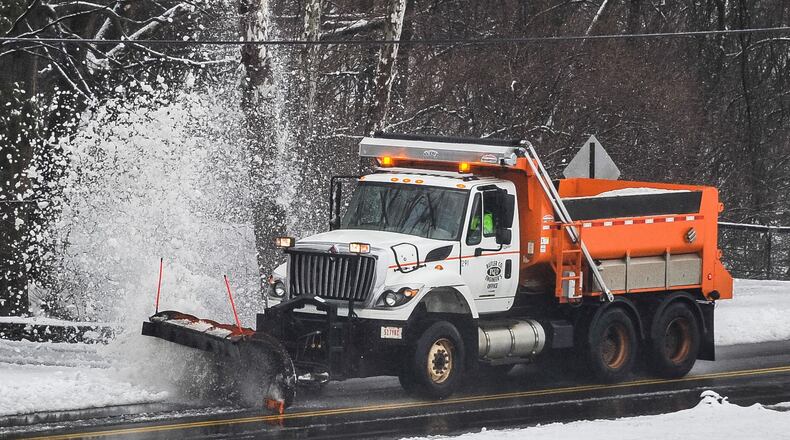“During negative periods of the Arctic Oscillation, temperatures can quickly swing from bitter to mild in just a few days. When the timing is right, big snows are possible if cold air meets up with the moisture,” said Storm Center 7 Chief Meteorologist McCall Vrydaghs.
These dramatic shifts in temperatures also could lead to more mixed precipitation storms filled with rain, freezing rain, sleet and snow, she said.
»BIZ BEAT: Average airfare at Dayton airport among top five most expensive
“Freezing rain, we all know, is the most deadliest form of winter weather because that can bring down power lines and makes roads really treacherous and slippery,” said Storm Center 7 Meteorologist Dontae Jones.
The Ohio Department of Transportation is preparing now for the winter months with operational readiness checks on equipment and making sure local groups have the right amount of salt and brine, said District 7 spokeswoman Mandi Dillon, who covers Montgomery, Clark, Champaign, Miami, Darke, Shelby, Logan, Auglaize and Mercer counties.
“Throughout the winter months, we are always watching the weather,” she said. “Depending on the temperatures, it does kind of change the treatment little bit. Obviously when you have just snow, it’s a lot easier to get out there and just plow. When you have ice you have to get that to melt a little bit more.”
The mix of precipitation can be tricky, Dillon said. Sometimes the big fluctuations can be helpful when warm weather keeps the ground temperature warmer before a storm comes in.
»RELATED: Kroger laying off hundreds of workers
“In some respects that can be helpful,” Dillon said. “Now when it comes in wet, when it comes in as rain, that can be a little more difficult because it’s harder for us to pretreat. If we put pretreatment down and then it rains it simply washes off the pavement.”
Those heavy fluctuations with frozen ground followed by excess precipitation could lead to flooding potential this winter as well, Jones said.
“If we do get flooding, no one wants it, but if we’re getting higher than average precipitation during any given month then that’s going to help alleviate some of the drought,” Jones said.
Dayton is still about six to eight inches below average precipitation for the year, Jones said. The drought conditions have been significant since August, following an extremely wet spring.
The winter months earlier this year, January through March, brought nearly 39 inches of precipitation, about 13.5 inches more than a normal year. That wet ground, combined with a wet fall in 2018 and more rain in spring 2019, contributed to a rough planting season for area farmers with fully saturated ground in May and June.
»BIZ BEAT: Popular Dayton sports complex makes a comeback following tornado
It’s hard to tell now what effect a wetter than normal winter will have on lawns and fields in the spring now because it’s unclear how much precipitation will fall this winter, Jones said.
Though potential cold snaps will likely cause area renter’s and homeowners to turn up their thermostats for some days this winter, experts say heating costs are expected to be about the same this year as last.
Between November 2018 and March, the five months considered the winter heating season, Vectren Energy Delivery of Ohio customers paid about $430, or an average $85 per month.
“Customers could see similar bill amounts this season thanks to continued low, stable natural gas prices,” said Richard Leger, Vectren vice president of Natural Gas Distribution, Indiana and Ohio. “Gas bills continue to remain very affordable compared to historic highs we’ve experienced in the past.”
FIVE FAST READS
• Action Sports finalizing plans for bigger indoor sports facility
• Needmore Kroger closing comes at ‘vulnerable time’ following tornadoes
• Magic Castle making large investment in entertainment center
• Here’s what to expect with your home heating prices this winter
• Business email scams target paychecks, accounts for companies
About the Author
